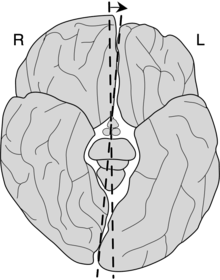Yakovlevian torque
Yakovlevian torque (also known as occipital bending (OB)[1] or counterclockwise brain torque[2]) is the tendency of the right side of the human brain to be warped slightly forward relative to the left and the left side of the human brain to be warped slightly backward relative to the right. This is responsible for certain asymmetries, such as how the lateral sulcus of the human brain is often longer and less curved on the left side of the brain relative to the right. Stated in another way, Yakovlevian Torque can be defined by the existence of right-frontal and left-occipital petalias, which are protrusions of the surface of one hemisphere relative to the other. It is named for Paul Ivan Yakovlev (1894–1983), a Russian-American neuroanatomist from Harvard Medical School.[3][4]

Effects
Handedness
A 2012 literature review showed that morphometry studies had consistently found that handedness-related effects corresponded to the extent of the Yakovlevian Torque[5]; increased torque, as measured by increased size of the right-frontal petalia and the left-occipital petalia, tends to be more common in right-handed individuals[6]. Individuals with mixed-handedness or left-handedness show reduced levels of Yakovlevian torque[7].
Developmental stuttering
Reduced right-frontal and left-occipital petalias and reversed petalia asymmetries (that is, left-frontal and right occipital petalias) have been associated with developmental stuttering in both adults and pre-adolescent boys[2]. This may be tied to the lateral sulcus housing Broca's area[5], which plays a significant role in production of language.
Bipolar disorder
Increased size of the left-occipital petalia, resulting from an abnormally high degree of Yakovlevian torque has been associated with bipolar disorder[1]. Maller et al. 2015 found that increased asymmetry of the occipital lobe, or occipital bending, was four times more prevalent in subjects with bipolar disorder than in healthy controls[1]. This applied both to patients with bipolar disorder type I and type II.
Presence in primates
Yakovlevian torque is found in modern humans and fossil hominids, appearing reliably as early as Homo erectus[6]. The patterning of petalias in extinct human ancestors is examined via endocasts, wherein a cast is made of the cranial vault: the asymmetries of human ancestors can be measured from these casts because petalias leave impressions inside the cranial vault[6].
Some authors have reported that similar petalia patterns are found in a number of primates including Old World monkeys, New World monkeys and Great apes[8], but others report different protrusions[9][10]; these differences seem to be tied to which techniques are used to measure the petalia, so it is not well-understood if all primates demonstrate Yakovlevian torque[6].
References
- Maller, Jerome J.; Anderson, Rodney; Thomson, Richard H.; Rosenfeld, Jeffrey V.; Daskalakis, Zafiris J.; Fitzgerald, Paul B. (2015-01-30). "Occipital bending (Yakovlevian torque) in bipolar depression". Psychiatry Research: Neuroimaging. 231 (1): 8–14. doi:10.1016/j.pscychresns.2014.11.008. ISSN 0925-4927. PMID 25480522.
- Mock, Jeffrey; Zadina, Janet; Corey, David; Cohen, Jeremy; Lemen, Lisa; Foundas, Anne (2012). "Atypical Brain Torque in Boys With Developmental Stuttering". Developmental Neuropsychology. 37 (5): 434–452. doi:10.1080/87565641.2012.661816. PMC 5537737. PMID 22799762.
- Toga, A.W.; Thompson, P.M. (2003). "Mapping brain asymmetry". Nat. Rev. Neurosci. 4 (1): 37–48. doi:10.1038/nrn1009. PMID 12511860.
- Carter, Rita, The Human Brain Book, p. 57, ISBN 978-0-7566-5441-2, Dorling Kindersley Limited, 2009
- Renteria, Miguel E. (March 26, 2012). "Cerebral Asymmetry: A Quantitative,Multifactorial, and Plastic Brain Phenotype" (PDF). Twin Research and Human Genetics. 15 (3): 401–413. doi:10.1017/thg.2012.13. PMID 22856374. Retrieved November 8, 2019.
- Phillips, Kimberly A.; Sherwood, Chet C. (June 11, 2007). "Cerebral Petalias and Their Relationship to Handedness in Capuchin Monkeys (Cebus apella)". Neuropsychologia. 45 (10): 2398–2401. doi:10.1016/j.neuropsychologia.2007.02.021. PMC 1959338. PMID 17418285.
- Guadalupe, Tulio; Willems, Roel; Zwiers, Marcel; Vasquez, Alejandro; Hoogman, Martine; Hagoort, Peter; Fernandez, Guillen; Jan, Buitelaar; Franke, Barbara; Fisher, Simon; Francks, Clyde (March 28, 2014). "Differences in cerebral cortical anatomy of left- and right-handers". Frontiers in Psychology. 5 (26): 261. doi:10.3389/fpsyg.2014.00261. PMC 3975119. PMID 24734025.
- Hopkins WD, Marino L. Asymmetries in cerebral width in nonhuman primate brains as revealed bymagnetic resonance imaging (MRI). Neuropsychologia 2000;38:493–499. [PubMed: 10683399]
- Holloway RL, De La Coste-Lareymondie MC. Brain endocast asymmetry in pongids and hominids: Some preliminary findings of the paleontology of cerebral dominance. American Journal of Physical Anthropology 1982;58:110–110.
- LeMay, M (1976). "Morphological cerebral asymmetries of modern man, fossil man, and nonhuman primate". Annals of the New York Academy of Sciences. 280 (1): 349–366. Bibcode:1976NYASA.280..349L. doi:10.1111/j.1749-6632.1976.tb25499.x. PMID 827951.